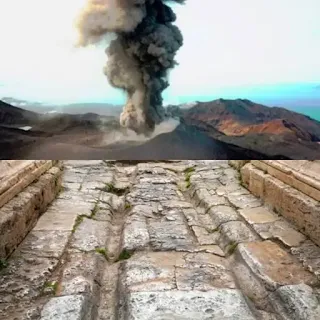Ibiko volcano, located in the Vernadsky mountain range on Paramushir Island, spewed a 2.5 km high column of volcanic ash.
read more
Stunning photography, meters away from Ibiko Volcano, of the moment it erupts a huge column of ash
The media office of the Russian Ministry of Emergency Situations in the Sakhalin region indicates that the volcanic ash column spread eastward for a distance of 5 kilometers. No ash fall was observed in the city of Severokorilsk, nor did the smell of hydrogen sulfide smell, and in general there was no threat to human activity.
It should be noted that the height of the Ibiko volcano is 1,156 meters, and it is seven kilometers from the city of Severokorilsk. It is a complex stratovolcano with several craters.
Italy : A forgotten Roman city was found after 1,500 years
Archaeologists have finally discovered a forgotten city dating back to the days of Julius Caesar in central Italy, which remained “lost” for about 1,500 years.
Due to its lack of any visible ruins, Interamna Lirenas, located in central modern Italy, was initially thought to be an "isolated" city that began its early decline around the turn of the first millennium.
Archaeologists say Interamna Lerinas was a "prosperous" Roman city that could have housed 2,000 people at its peak.
Although in the 1980s archaeologists considered it just a small settlement, it was a large city complete with dwellings, a temple, baths and a roofed theatre.
Scientists focused on pottery and building foundations from excavations, in addition to the results of geophysical surveys of the Earth.
Excavations at the site began in 2010, but the results have not been published until now. The 13-year study was led by Dr Alessandro Lunaro at the University of Cambridge's School of Classics.
Evidence revealed that Interamna Lerinas was “prosperous” until the third century AD, when civil wars, barbarian invasions, and political conflicts began to sweep through the Roman Empire.
“Strategically located between a river and a major road, Interamna Lerenas served as a thriving node in the regional urban network,” Lunaro said. “It would have been valuable as it sought to consolidate support throughout Italy during the civil wars. This city played its cards.” Consistently correct, it was always establishing relationships with communities between Rome and southern Italy while thriving as a commercial centre.
Interamna Lerinas was founded in 312 BC, during the era of the Roman Republic (the era before the mighty Roman Empire). The city received the patronage of the Roman general Julius Caesar in 46 BC, two years before his murder (leading to the formation of the Roman Empire in 27 BC).
But Interamna Lerinas was abandoned in the 6th century, about 100 years after the collapse of the empire.
According to Dr. Lunaro, this city managed to "resist the decline of the empire", but exactly how this happened remains unclear. Adding: “We believe that local and regional networks (political, social and economic) have proven their ability to withstand and have allowed life to continue.”
Interamna Llerinas was home to a number of magnificent buildings that no longer stand, and only their foundations are now visible after excavations.
The site, about 130 km from Rome, is now mostly crop fields, but Dr Lunaro's team found the remains of a 1,500-seat covered theatre, a market place, a temple, a bath complex and a large warehouse, suggesting that the city was a river port. .
Like Pompeii and Herculaneum, Interamna Lerinas shows no sign of zoning or separation by social status and was crowded with houses of various sizes.
In all, 190 homes in town (or 84 percent of homes) were small (less than 5,380 square feet), 25 were larger (between 5,380 and 10,700 square feet), and only five were larger than 10,700 square feet.
The team also found 19 “courtyard buildings” that they believe may have served as indoor market buildings, residential complexes and public warehouses.
Dr Lunaro and his colleagues did not find a layer of ash or any other evidence to suggest that the city was destroyed as violently as Pompeii and Herculaneum. Alternatively, the population may have abandoned the city amid "increasing insecurity" sometime in the sixth century.


Good
ReplyDelete